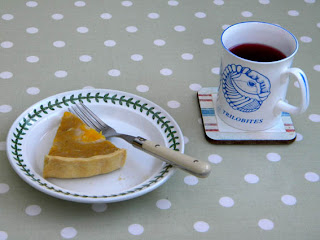Our pumpkins have ripened and are looking good. We have 3 fine specimens and a big pumpkin that the slugs have discovered. A good proportion of it has been eaten into and the slugs were close to finding the other pumpkins, so they have now been harvested and cleaned.
Not to be wasteful, I cut out the damaged side of the slug infested pumpkin and was left with a good chunk to salvage. Once opened, the pumpkin would not save, so I decided to make a pumpkin pie.
Chop up the pumpkin into slices and remove the inner pith and outer skin. Cut the flesh into small cubes and steam for about 20 minutes to soften. Mash into a purée. and cool.
Make some pastry (350g flour, 200g margarine or butter and a small amount of water) and line a pie dish.
500g pumpkin purée
175g light brown sugar
+cinnamon, ginger and nutmeg
200g milk (condenced milk is an alternative)
3 eggs
Mix the ingredients thoroughly and add to the dish. Bake at 200 degrees Celsius for 30 minutes.
The pumpkin pie needs to cool before it is cut and then it should give a crisp and clean slice. OK! I made two small ones in flan dishes, which is probably the best way to do the job. I had enough pastry and pumpkin purée left over to make a small pasty with pumpkin, nutmeg and honey.
Just the job after a hard days leisure now that the weather is starting to become Autumnal.















